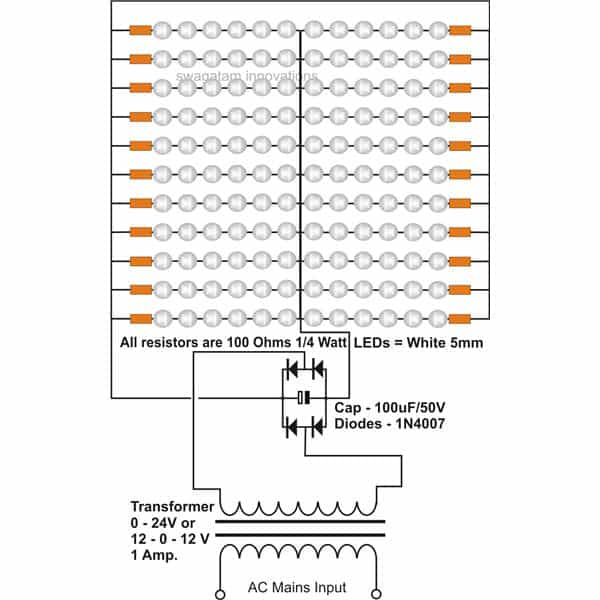If you are concerned that an LED light with a transformerless base might not be dependable or sufficiently powerful, you may get equivalent results by using a transformer-based power supply system, as demonstrated below.
LED Lamp using a Transformer or Battery
The construction of a basic LED light with a transformer-based power supply and the appropriate number of LEDs connected in series and parallel connections will be covered in the subsequent sections.
Because white LEDs have a great power efficiency, adopting them to light our houses is starting to become more and more common.
The schematic depicts a simple arrangement with many LEDs placed in parallel and series.
Circuits Description
By utilizing a transformer to drive the LEDs, the LED bank is able to be illuminated with a high degree of brightness, as can be seen in the diagrammed LED lamp circuit application.
Standard bridge and capacitor networks are incorporated into the power supply to provide the necessary rectification and filtering of the supplied voltage to the LEDs.
The following method is used for organizing the LEDs:
A white LED's forward voltage of about 3 volts is divided by the supply voltage of 24, which equals 24/3 = 6. This indicates that the supply voltage can sustain a maximum of 6 LEDs in series.
Nevertheless, since we want to use a large number of LEDs (132 in this case), we must join a large number of these series LED strings using parallel wiring.
Here, we precisely carry out that task.
As seen in the illustration, an overall of 22 strings with six LEDs each are linked in parallel.
A limiting resistor is connected in series with each string as current limiting poses a significant problem with the white LEDs.
Users can modify the LED lamp's total luminosity by optimizing the resistor's value.
A modest 10 by 10 room may be brilliantly lit with the help of the suggested design, which will only use 0.02 x 22 = 0.44 Amps or 0.44 x 24 = 10.56 watts of power.
Transformer-Powered 24-Volt LED Lamp Circuit Diagram

In the above designs we have learned how to make LED lamp without any current control which may be OK if the LEDs are not power LEDs and do not have the property of getting too hot due the extremely high bright illumination.
However for power LEDs which are designed to emit extremely high bright lights and which have the tendency to become too warm quickly, a heatsink and a current control feature become very important.
Leave a Reply